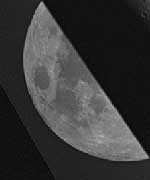

Image credit: BBSO
Scientists who monitor Earth’s reflectance by measuring the moon’s “earthshine” have observed unexpectedly large climate fluctuations during the past two decades. By combining eight years of earthshine data with nearly twenty years of partially overlapping satellite cloud data, they have found a gradual decline in Earth’s reflectance that became sharper in the last part of the 1990s, perhaps associated with the accelerated global warming in recent years. Surprisingly, the declining reflectance reversed completely in the past three years. Such changes, which are not understood, seem to be a natural variability of Earth’s clouds.
The May 28, 2004, issue of the journal Science examines the phenomenon in an article, “Changes in Earth’s Reflectance Over the Past Two Decades,” written by Enric Palle, Philip R. Goode, Pilar Montaes Rodriguez, and Steven E. Koonin. Goode is distinguished professor of physics at the New Jersey Institute of Technology (NJIT), Palle and Monta=F1es Rodr=EDguez are postdoctoral associates at that institution, and Koonin is professor of theoretical physics at the California Institute of Technology. The observations were conducted at the Big Bear Solar Observatory (BBSO) in California, which NJIT has operated since 1997 with Goode as its director. The National Aeronautics Space Administration funded these observations.
The team has revived and modernized an old method of determining Earth’s reflectance, or albedo, by observing earthshine, sunlight reflected by the Earth that can be seen as a ghostly glow of the moon’s “dark side”-or the portion of the lunar disk not lit by the sun. As Koonin realized some 14 years ago, such observations can be a powerful tool for long-term climate monitoring. “The cloudier the Earth, the brighter the earthshine, and changing cloud cover is an important element of changing climate,” he said.
Precision earthshine observations to determine global reflectivity have been under way at BBSO since 1994, with regular observations commencing in late 1997.
“Using a phenomenon first explained by Leonardo DaVinci, we can precisely measure global climate change and find a surprising story of clouds. Our method has the advantage of being very precise because the bright lunar crescent serves as a standard against which to monitor earthshine, and light reflected by large portions of Earth can be observed simultaneously,” said Goode. “It is also inexpensive, requiring only a small telescope and a relatively simple electronic detector.”
By using a combination of earthshine observations and satellite data on cloud cover, the earthshine team has determined the following:
Earth’s average albedo is not constant from one year to the next; it also changes over decadal timescales. The computer models currently used to study the climate system do not show such large decadal-scale variability of the albedo.
The annual average albedo declined very gradually from 1985 to 1995, and then declined sharply in 1995 and 1996. These observed declines are broadly consistent with previously known satellite measures of cloud amount.
The low albedo during 1997-2001 increased solar heating of the globe at a rate more than twice that expected from a doubling of atmospheric carbon dioxide. This “dimming” of Earth, as it would be seen from space, is perhaps connected with the recent accelerated increase in mean global surface temperatures.
2001-2003 saw a reversal of the albedo to pre-1995 values; this “brightening” of the Earth is most likely attributable to the effect of increased cloud cover and thickness.
These large variations, which are comparable to those in the earth’s infrared (heat) radiation observed in the tropics by satellites, comprise a large influence on Earth’s radiation budget.
“Our results are only part of the story, since the Earth’s surface temperature is determined by a balance between sunlight that warms the planet and heat radiated back into space, which cools the planet,” said Palle. “This depends upon many factors in addition to albedo, such as the amount of greenhouse gases (water vapor, carbon dioxide, methane) present in the atmosphere. But these new data emphasize that clouds must be properly accounted for and illustrate that we still lack the detailed understanding of our climate system necessary to model future changes with confidence.”
Goode says the earthshine observations will continue for the next decade. “These will be important for monitoring ongoing changes in Earth’s climate system. It will also be essential to correlate our results with satellite data as they become available, particularly for the most recent years, to form a consistent description of the changing albedo. Earthshine observations through an 11-year solar cycle will also be important to assessing hypothesized influences of solar activity on climate.”
Monta=F1es Rodr=EDguez says that to carry out future observations, the team is working to establish a global network of observing stations. “These would allow continuous monitoring of the albedo during much of each lunar month and would also compensate for local weather conditions that sometimes prevent observations from a given site.”
BBSO observations are currently being supplemented with others from the Crimea in the Ukraine, and there will soon be observations from Yunnan in China, as well. A further improvement will be to fully automate the current manual observations. A prototype robotic telescope is being constructed and the team is seeking funds to construct, calibrate, and deploy a network of eight around the globe.
“Even as the scientific community acknowledges the likelihood of human impacts on climate, it must better document and understand climate changes,” said Koonin. “Our ongoing earthshine measurements will be an important part of that process.”
Original Source: Caltech News Release
December 3rd, 2018, NASA's Origins, Spectral Interpretation, Resource Identification, and Security?Regolith Explorer (OSIRIS-REx) successfully rendezvoused…
The Andromeda Galaxy, our nearest large neighbour, has 36 identified dwarf galaxies. The Hubble telescope…
Rogue planetary-mass objects, also known as free-floating planets (FFPs) drift through space alone, unbound to…
The effects of Climate Change on Earth's living systems have led to a shift in…
Our Milky Way Galaxy is rich in dark matter. The problem is, we can't see…
Neutrinos generated through solar fusion reactions travel effortlessly through the Sun's dense core. Each specific…